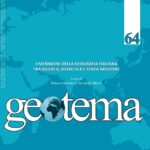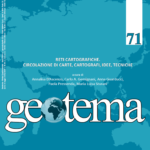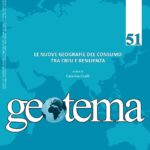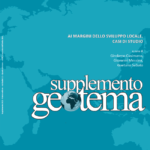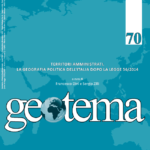Paola Pressenda, Paola Sereno
Il nucleo antico del patrimonio geografico dell’Università di Torino: origine e dispersione
L’attivazione di un insegnamento di geografia dal 1848, poi soprattutto l’istituzione della prima cattedra nell’Ateneo torinese (Facoltà di Lettere e Filosofia, 1857) e la conseguente fondazione del Gabinetto di Geografia (1867-1868) danno origine al nucleo più antico del patrimonio geografico di quell’Università, a eccezione di un fondo ancora più antico già presente nella Biblioteca dell’Università, la quale tuttavia darà origine più tardi alla Biblioteca Nazionale. Nonostante la perdita dei registri inventariali e le lacune documentarie, le autrici ricostruiscono, sulla base di documentazione inedita dell’archivio storico dell’Ateneo e delle segnature inventariali su carte e volumi ancora conservati, le vicende di quella fase originaria di patrimonializzazione fino al 1945, che costituisce il primo nucleo storico al quale, dal 1936-1937, si affiancano quelli sorti attorno alle cattedre di Geografia delle nuove Facoltà di Economia e Commercio e Magistero. L’assetto attuale di tutti e tre i nuclei patrimoniali storici – e quindi anche la possibilità di studiarli – risente fortemente delle troppo numerose riorganizzazioni susseguitesi dagli anni Settanta del secolo scorso fino a oggi, indifferenti al valore e al significato storico dei patrimoni generati dalle strutture che si abolivano, con esiti disastrosi sulla trasmissione e valorizzazione del patrimonio, a iniziare dalla perdita di tutti gli strumenti e dalla dispersione di libri e carte. Le autrici auspicano quindi che gli studi intrapresi sui patrimoni geografici sollecitino un protocollo di tutela della loro storia e della loro organizzazione spaziale, in quanto essi stessi fonti materiali della storia della disciplina.
Abstract: The Ancient Nucleus of the Geographical Heritage of the University of Turin: Origin and Dispersion
The activation of a teaching of Geography from 1848, and then above all the establishment of the first chair in the Turin University (Faculty of Arts, 1857) and the consequent foundation of the Institute of Geography (1867-1868) give rise to the oldest geographic heritage of that University, with the exception of a more ancient core of volumes belonging to the University Library, which however will later give rise to the National Library. Despite the loss of inventory records and documentary gaps, the authors reconstruct, on the basis of unpublished documentation of the historical archive of the University and the inventory signatures on maps and volumes still preserved, the events of that original phase of capitalization until 1945, which constitutes the first historical nucleus which, from 1936-1937, is flanked by those built around the chairs of Geography of the new Faculties of Economics and Pedagogy. The present structure of all the three historical cores – and therefore also the possibility of studying them – is strongly affected by the too many reorganizations that have followed from the Seventies until today, indifferent to the value and historical significance of the assets generated by the institutions that were abolished, with disastrous results on the transmission and enhancement of heritage, starting with the loss of all the scientific instruments and the dispersion of books and maps. The authors therefore hope that the studies undertaken on geographical heritage call for a protocol to protect their history and their spatial organization, as they themselves are material sources of the history of the discipline.
Résumé: L’ancien noyau du patrimoine géographique de l’Université de Turin: origine et dispersion
L’activation d’un enseignement de Géographie à partir de 1848, puis surtout la création de la première chaire à l’Université de Turin (Faculté des Lettres et Philosophie, 1857) et la fondation conséquente du Cabinet de Géographie (1867-1868) donnent naissance au noyau le plus ancien du patrimoine géographique de cette Université, à l’exception d’une plus ancienne collection des livres appartenant déjà à la Bibliothèque universitaire, qui cependant donnera lieu à la Bibliothèque Nationale. Malgré la perte des registres d’inventaire et les lacunes documentaires, les auteurs reconstituent, sur la base de la documentation inédite des archives historiques de l’Université et des marquages d’inventaire sur les cartes et volumes encore conservés, les événements de cette phase originale de patrimonialisation jusqu’en 1945, qui constitue le premier noyau historique qui, à partir de 1936-1937, est flanqué de ceux construits autour des chaires de Géographie des nouvelles Facultés d’Économie et de Pédagogie. La structure actuelle des trois patrimoines historiques – et donc aussi la possibilité de les étudier – est fortement affectée par les trop nombreuses réorganisations qui ont suivi depuis les années Soixante-dix du siècle dernier jusqu’à aujourd’hui, indifférentes à la valeur et à l’importance historique des collections générées par les institutions abolies, avec des résultats désastreux sur leur transmission et valorisation, à commencer par la perte de tous les instruments scientifiques et la dispersion des livres et des cartes. Les auteurs espèrent donc que les études menées sur le patrimoine géographique appellent à un protocole pour protéger leur histoire et leur organisation spatiale, car ils sont eux-mêmes des sources matérielles de l’histoire de la discipline.
Parole chiave: storia della geografia, Gabinetto di Geografia, collezioni geografiche, trasmissione patrimoniale
Keywords: history of geography, Institute of Geography, geographic collections, heritage transmission
Mots-clés : histoire de la géographie, Cabinet de Géographie, collections géographiques, transmission patrimoniale


